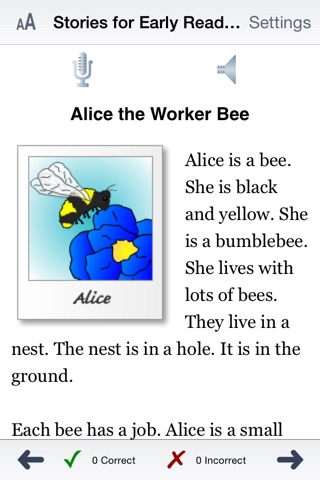
Reading for Details: III app for iPhone and iPad
Developer: Learning Fundamentals, Inc.
First release : 31 May 2014
App size: 8.21 Mb
This app has has 30 short stories. Most of the words are 1 or 2 syllables. The words are in simple sentences. Just like this one. Sentences have 5 to 8 words. The stories are fun for early readers.
After carefully reading a story, the student answers three simple questions and one question that requires the student to recall multiple items from the story. Since the stories are aimed at very early readers, the questions are straightforward. They do not require making inferences or judgements. In most cases, the correct answer can be found word-for-word in the story. At the end of the question section of each story, there is an open-ended question for discussion.
This is the first app in the Reading for Details series of apps. They were designed for individuals who need extra practice with reading comprehension. Their focus is on learning how to recall specific details of the stories. They are also appropriate for children and adults with traumatic brain injuries or stroke. Ideally, the student will work with a parent, teacher, or therapist while using the app. The mentor can guide the student’s reading strategies while using the app as a source of stories and questions.
Reading for Details: Stories for Early Reading is the simplest app in the series. The vocabulary and sentence structure are appropriate for early readers or children who are having difficulty with complex stories.
Reading for Details I has short sentences with words that are are appropriate for 1st—3rd grade readers. Paragraphs are usually short. Sentence structure is simple and information is directly stated. Stories generally have between 350 and 400 words.
Reading for Details II has stories written by authors from around the world and a vocabulary that should be familiar to 4th—6th grade students. Words and idiomatic phrases from other cultures are often used and defined in the stories. This adds an element of cultural diversity and allows the reader to see events from another’s perspective.
Reading Strategy: As the students read the stories, they should focus on the details of the story. At the end of the story, they should pause and decide what the story was mostly about and who the main characters are. The questions explicitly rely on facts in the story. The stories are aimed at very early readers so the questions are straightforward. They do not require making inferences or judgements. In most cases, the correct answer can be found word-for-word in the story. The fourth question usually requires the student to recall multiple items from the story. At the end of each quiz section of the story there is an open-ended question for discussion.
There are no trick questions in the app. However, there are answers that contain details from the story that are irrelevant to the question. These foils are intentionally placed to make sure the reader is reading for information and not just using recognition memory to answer the question.
Often the student gets a question wrong because they focus on a specific detail of the story. Sometimes they recognize words or numbers in the answers and choose an answer because the words are familiar. The popup explains why incorrect answers may appear to be correct. It also explains why the correct answer is, in fact, the right choice. After the student studies the explanation, they should read the question again and answer it using the knowledge gained from the explanation. They can swipe back to the story, reread it, and look for the answer. An option lets them choose to see the explanations after each answer, rather than just after incorrect answers.
The stories can be read in any order, but we have provided a default order based on complexity, vocabulary, and number of details.
The app scores correct and incorrect answers and keeps track of the questions that were answered incorrectly. Results can be emailed or downloaded using iTunes.



